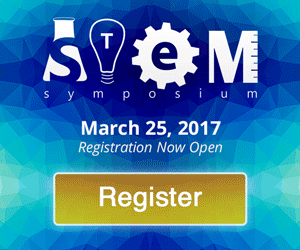
Meet Aaditya Singh, a sophomore at Thomas Jefferson High School for Science and Technology. He also happens to be a rising freshman at MIT.
When you meet a student as bright as Singh – he’s taken courses such as differential equations, artificial intelligence, quantum mechanics and organic chemistry – you might be quick to make a few assumptions.
So let’s set the record straight.
“My parents never pressured me to pursue STEM,” says Singh, referring to the field of study that encompasses science, technology, engineering and mathematics. “When I chose STEM,” he adds, “I felt I had made an independent decision – and that increased my interest in the field.”
If you’re wondering how to get your child interested in STEM, too – in the same no-pressure way – now’s your chance.
On Saturday, March 25, Singh will be speaking at WashingtonExec’s 4th annual STEM Symposium. This annual gathering, held at Nysmith School for the Gifted in Herndon, Va., attracts 3,500 educators, industry experts, parents and students all interested in furthering STEM engagement among future generations of students.
Speaking at the Symposium, Singh will share his own STEM journey, including his inspirations – and what others can learn from his experience. Among those lessons: The best way to learn STEM is to see its relevance in your own life.
“I think the first step is seeing how STEM connects to your life – for me, this was through math in board games,” says Singh, whose math acuity has led him to represent the United States at the international math competition, Mathematical Kangaroo. “After you make this initial connection with STEM, you just have to let the interest grow on its own – nurture it but don’t pressure it.”
Some of Singh’s earliest memories of STEM include watching episodes of Cyberchase, a math-focused show on PBS Kids; as well as playing math-related games like 24 Challenge.
“I also started applying my newly developed math skills to games like Monopoly, which helped foster my interest [in applied mathematics and computation],” says Singh, who’s an avid board game player (and piano player, too).
Singh also credits his early education at Nysmith with helping nurture an interest in STEM.
“From fun science projects to my first coding experiences with MSWLogo, I immediately took a liking to the field,” says Singh. Plus, Singh’s older sister was an early inspiration.
“My sister was a huge source of encouragement as I pursued STEM,” says Singh. “I was also encouraged by all my teachers and administrators at Nysmith, Longfellow, Langley and TJ – I’d like to thank all of them for helping me pursue my interests in STEM.”
Singh’s interest in STEM goes well beyond the classroom. He’s part of the TJ Varsity Math Team, Science Olympiad Team and Science Bowl Team. Plus, for the past two summers, he’s interned at a tech startup, where he worked on prototyping new features using Ruby on Rails. He’s also interned at a scientific consulting firm, where he worked on a Defense Advanced Research Projects Agency (DARPA) project, applying math to systems engineering environments.
One thing Singh is quick to dispel is the notion that STEM is somehow, well, nerdy. “I think many students consider STEM ‘nerdy’ or ‘anti-social,’” says Singh. “But they don’t realize that it doesn’t have to be – some of my most memorable moments, with my friends, are from math contests or during science class!”
None of those interests, says Singh, would have happened without the support of his parents. “I think the biggest – and most important – role parents can play in getting students involved in STEM is providing ample opportunities to be exposed to and enjoy STEM,” says Singh. That’s where Singh’s own parents made a difference.
“From never saying ‘no’ to a game of monopoly to driving me to math competitions, my parents made sure I could pursue my interests,” says Singh. “My parents always ensured I had the necessary educational resources to pursue my interests as well.”
If you’re wondering how STEM can be fun, interactive and an everyday part of your child’s life, now’s your chance. Hear Singh share more of his STEM journey at the upcoming STEM Symposium. Register here.


